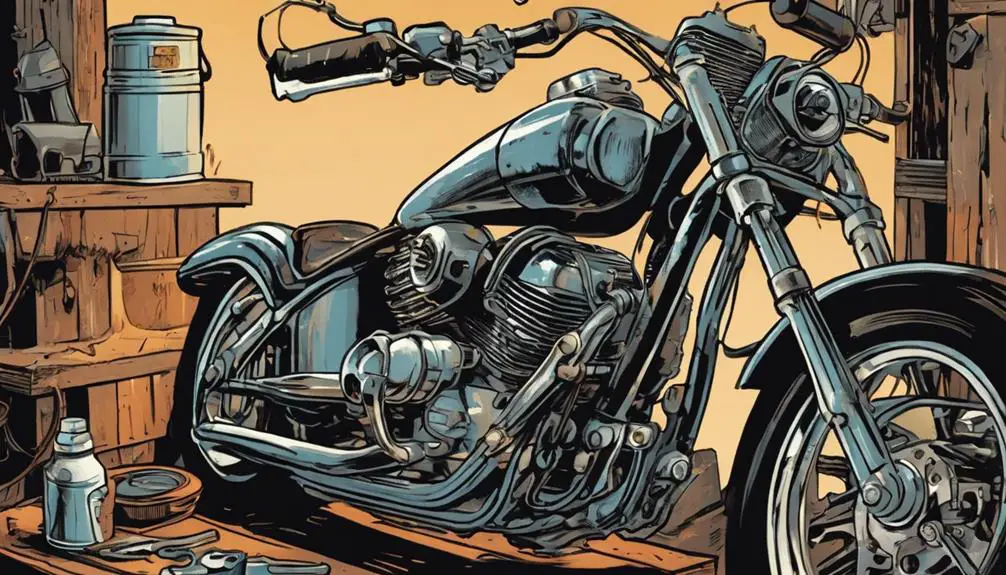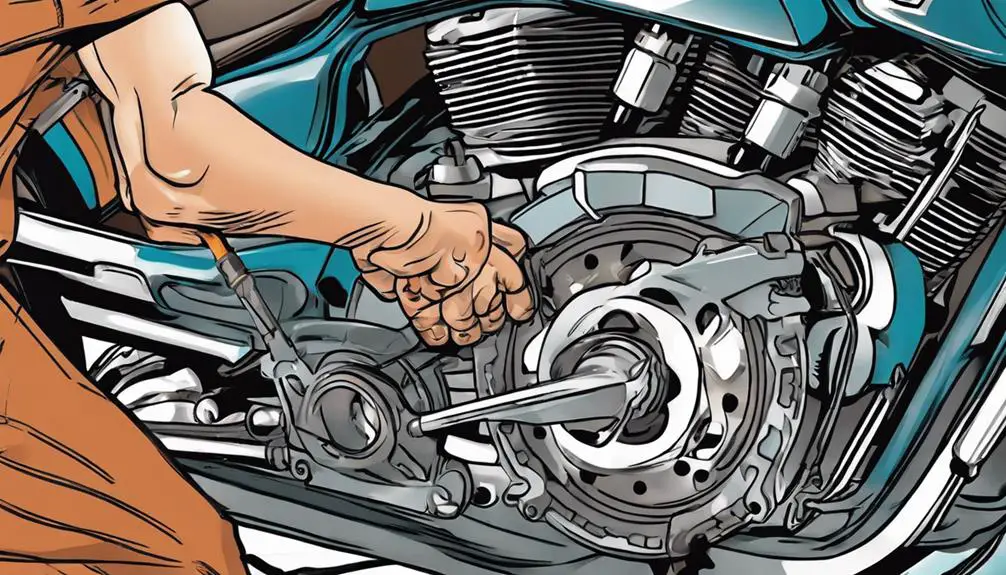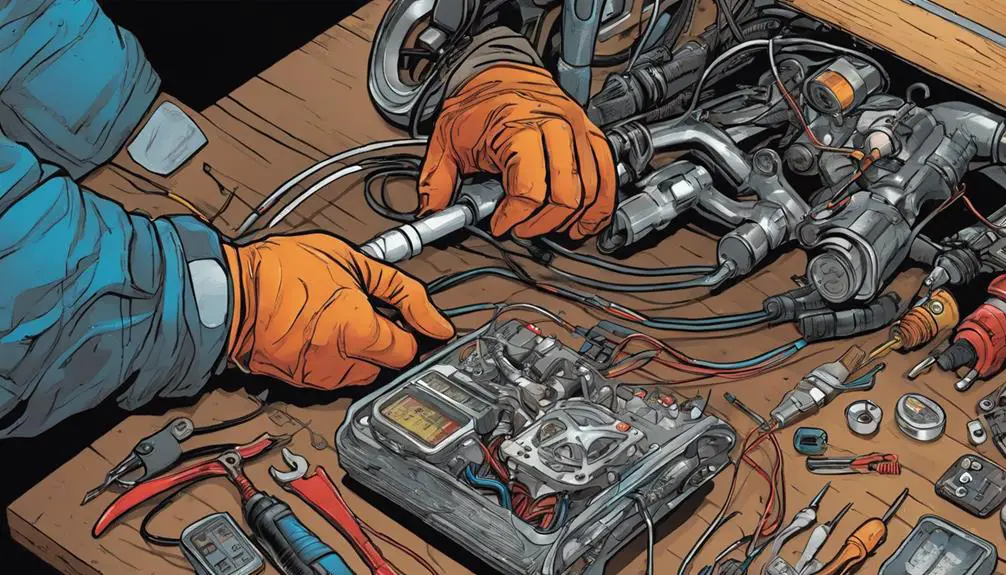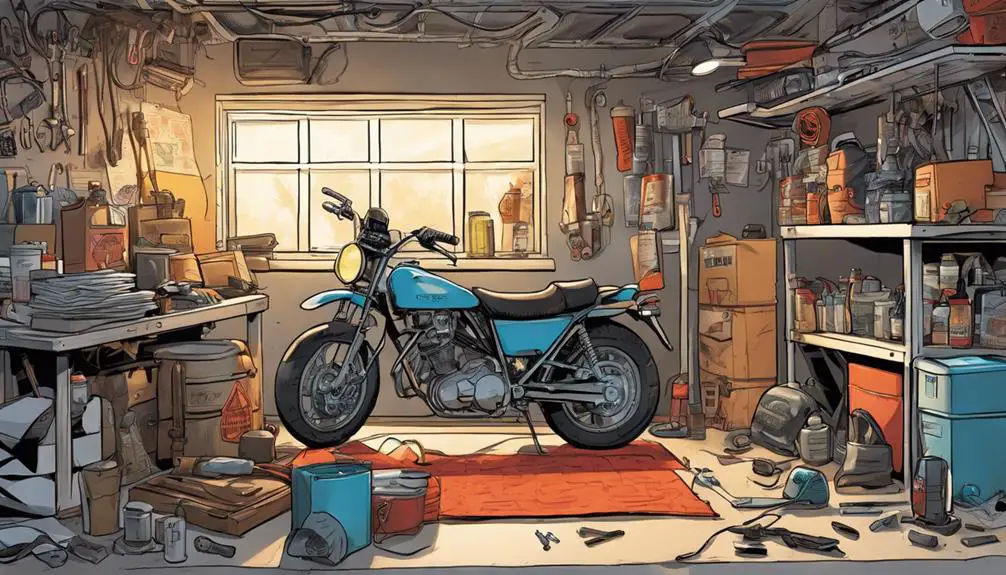If you're new to motorcycle ownership, understanding maintenance is vital for both safety and performance. You might think oil changes and tire checks are enough, but there's more to keeping your ride in top shape. Regular inspections of your brakes, chain, and electrical system can prevent costly repairs down the line. Plus, knowing how to care for your bike during seasonal changes is important for longevity. Curious about the specifics of these maintenance tips? You'll want to know what to prioritize to guarantee a smoother, safer ride.
Key Takeaways
- Perform regular oil changes every 3,000 to 5,000 miles to ensure engine efficiency and longevity.
- Check tire pressure monthly to enhance handling and prevent tire wear; adjust based on temperature changes.
- Inspect brake pads at least monthly for wear; replace them if you hear squeaking or grinding sounds.
- Clean and lubricate the chain regularly to prevent excessive wear and ensure optimal performance.
Regular Oil Changes

Regular oil changes are essential for keeping your motorcycle's engine running smoothly and efficiently. When you change the oil regularly, you're not just following a chore; you're empowering your ride, ensuring it performs at its best. Fresh oil lubricates moving parts, reduces friction, and prevents overheating. This isn't just maintenance; it's about freeing your machine to release its full potential.
You should check your oil level and quality frequently. If the oil appears dark or gritty, it's time for a change. Don't wait until you hear that dreaded knocking sound—be proactive. Most motorcycles require oil changes every 3,000 to 5,000 miles, but it's wise to consult your owner's manual for specific recommendations.
When you're ready to change the oil, gather your tools and materials. You'll need a wrench, an oil filter, and the right type of oil for your bike. As you drain the old oil, take a moment to appreciate the process. This simple act keeps your motorcycle in top shape, allowing you to feel the freedom of the open road.
Embrace this part of your maintenance routine, and ride with confidence.
Tire Maintenance Essentials
Tire maintenance is vital for your safety and performance on the road.
You need to regularly check your tire pressure and inspect the tread depth to guarantee your motorcycle handles well.
Keeping an eye on these essentials will help you enjoy a smoother ride and extend the life of your tires.
Tire Pressure Checks
Checking your motorcycle's tire pressure is essential for safety and performance. Properly inflated tires enhance your ride's handling, improve fuel efficiency, and reduce the risk of blowouts. You want to feel that freedom on the open road, and tire pressure plays an important role in making that happen.
Start by checking your tire pressure at least once a month and before any long ride. Use a reliable gauge to get an accurate reading. Remember, tire pressure can fluctuate with changes in temperature, so adjust accordingly. The recommended pressure is typically found on the tire sidewall or in your owner's manual—make sure you're familiar with it.
To check, remove the valve cap and press the gauge onto the valve stem. Make sure the reading matches the recommended level. If it's low, inflate your tires to the correct pressure, ensuring you do so gradually and evenly. Don't forget to replace the valve cap tightly.
Regular tire pressure checks not only enhance your safety but also keep your riding experience smooth and exhilarating. Stay vigilant, and you'll enjoy the ride without unnecessary worry. Keep your spirit of adventure alive!
Tread Depth Inspection
Ensuring your motorcycle's tires have adequate tread depth is just as important as maintaining proper pressure for safe and enjoyable rides. Tread depth directly affects your traction, handling, and braking, especially in wet or uneven conditions. When you're out there chasing freedom on the open road, the last thing you want is a slip or slide due to worn-out tires.
To check your tread depth, grab a simple tool like a penny. Insert it into the grooves with Lincoln's head facing down. If you can see all of Lincoln's head, it's time to replace your tires. Most experts recommend replacing tires when tread depth falls below 2/32 of an inch.
Make a habit of inspecting your tires regularly, ideally before each ride. Look for signs of uneven wear, cracks, or bulges. If you notice any issues, it's worth consulting a professional.
Brake System Checks

When it comes to safety, your brake system is essential, so don't overlook it.
You should inspect your brake pads regularly, check your brake fluid levels, and test your brake performance frequently.
Keeping these checks in mind will help guarantee your ride is both safe and smooth.
Inspect Brake Pads Regularly
Regularly inspecting your brake pads is essential for maintaining a safe and reliable ride. There's nothing like the freedom of the open road, but that freedom can quickly turn into a nightmare if your brakes fail. Keep that exhilarating feeling alive by ensuring your brake pads are in top shape.
Check your brake pads for wear and tear at least once a month. If you notice any of these signs, it's time for a replacement:
- Squeaking or grinding sounds when you brake can signal that your pads are worn down and need attention.
- Vibration or pulsation in the brake lever can indicate uneven wear, which can compromise your safety.
Taking these simple steps not only protects your safety but also enhances your riding experience. Embrace the thrill of the ride without fear of brake failure; stay vigilant, and let your spirit soar.
Your bike deserves that care, and so do you!
Check Brake Fluid Levels
You should check your brake fluid levels frequently to maintain ideal braking performance and safety on your motorcycle. Brake fluid is essential for ensuring your brakes engage smoothly and effectively, allowing you to ride freely without fear. A low fluid level can lead to a spongy brake feel or total brake failure—definitely not what you want on the open road.
To check your brake fluid, locate the reservoir, usually found near the handlebars or under the seat. Make sure you're parked on a level surface, and inspect the fluid level against the markings on the reservoir. If it's below the minimum line, it's time to top it up with the appropriate type of brake fluid specified in your owner's manual.
Keep in mind that brake fluid can absorb moisture over time, which can compromise its performance. So, it's a good idea to change it periodically, as recommended by your manufacturer. Being proactive about your brake fluid levels not only enhances your riding experience but also empowers you to embrace the freedom of the road with confidence.
Stay vigilant, and your motorcycle will thank you for it!
Test Brake Performance Frequently
Checking your brake fluid levels is just the first step; testing your brake performance frequently guarantees your motorcycle responds effectively when you need it most.
Regular brake checks can mean the difference between a smooth ride and a heart-stopping moment. Don't take chances with your safety. You deserve the freedom to ride without worry.
Here are a few essential practices for testing your brake performance:
- Listen for unusual sounds – Grinding or squeaking can signal that your brakes need attention.
- Feel for responsiveness – If your brake lever feels soft or spongy, it's time to investigate further.
Chain and Sprocket Care
How often do you think about maintaining your motorcycle's chain and sprockets, when these components are essential for smooth rides and overall performance? Keeping them in top condition is key to ensuring your freedom on the road.
Start by checking the chain tension regularly; too loose or too tight can lead to excessive wear or even breakage.
Next, clean the chain to remove dirt and grime. A clean chain reduces friction and enhances efficiency. Use a quality chain cleaner and a brush to scrub it down, then rinse and dry thoroughly.
After cleaning, lubricate the chain with a suitable chain lube, applying it evenly while rotating the wheel for full coverage.
Don't forget to inspect the sprockets for any signs of wear, such as hooked teeth or uneven surfaces. If you notice any damage, it's time to replace them.
Lastly, give your chain and sprockets a quick check before long rides. A well-maintained chain and sprockets not only boost performance but also add to your sense of liberation as you navigate the open road with confidence.
Electrical System Inspection

Regular maintenance of your motorcycle's chain and sprockets naturally leads to the importance of inspecting the electrical system, as a reliable electrical setup is vital for smooth operations and overall safety on the road. Imagine the freedom of the open road, only to be interrupted by electrical failures. You won't want that!
Start by checking your battery; verify it's securely mounted and free of corrosion. Clean connections and tight terminals can prevent unexpected breakdowns.
Next, inspect the wiring. Look for frayed or damaged wires that could lead to shorts or failures.
Finally, test your lights and indicators to make sure they're working correctly. You want others to see you, especially when you're out there embracing your passion.
- Feel the thrill of night rides without worrying about electrical failures.
- Experience the joy of cruising with full confidence in your bike's reliability.
Taking these steps not only enhances your safety but also enriches the exhilarating experience of riding. Embrace the journey, and keep your bike electrifyingly alive!
Cooling System Management
Managing your motorcycle's cooling system is essential to prevent overheating and guarantee peak performance during your rides. A well-functioning cooling system allows you to push the limits of your bike while enjoying the freedom of the open road without worry.
Start by checking the coolant level regularly. Your owner's manual will guide you on the recommended levels. If it's low, top it up with the appropriate coolant mixture—don't just use water, as that can lead to corrosion.
Inspect hoses and connections for leaks or cracks, as even minor issues can lead to significant overheating problems.
Additionally, make sure to clean your radiator regularly. Dirt and debris can obstruct airflow, reducing cooling efficiency. A simple spray with water can do wonders, but if you're in a dusty environment, you may need to perform this more frequently.
Lastly, consider the weather conditions. If you're riding in extreme heat, monitor your engine temperature closely. If it starts climbing too high, pull over and give your bike a break.
Seasonal Storage Tips

Properly storing your motorcycle during the off-season is crucial to guarantee it remains in top condition for your next ride. You want to feel that rush of freedom as soon as you hop back on, so taking the right steps now will make all the difference.
Start by cleaning your bike thoroughly, removing any dirt or grime that could cause damage over time. Next, fill the tank with fuel and add a fuel stabilizer to prevent any gunk from forming.
Here are a few essential tips to keep your bike happy during storage:
- Protect from rust: Use a good-quality cover to shield your motorcycle from moisture and dust.
- Check the battery: Remove your battery and store it in a cool, dry place, or use a battery maintainer to keep it charged.
Frequently Asked Questions
How Often Should I Wash My Motorcycle?
You should wash your motorcycle whenever it gets dirty, but a good rule of thumb is every two to four weeks.
If you ride through mud, rain, or on salty roads, clean it more often to prevent corrosion and damage.
Regular washes not only keep it looking sharp but also help you spot potential issues before they become problems.
What Tools Do I Need for Basic Maintenance?
For basic maintenance, you'll need a few essential tools.
Grab a set of metric or standard wrenches, screwdrivers, and pliers.
A torque wrench is vital for tightening bolts properly.
Don't forget an oil filter wrench, a funnel, and a drain pan for changing oil.
A cleaning brush and rags will help keep your bike looking sharp.
With these tools, you're empowered to tackle maintenance and keep your ride running smoothly!
How Can I Identify Weird Noises From My Bike?
When you hear strange sounds from your bike, start by listening closely.
Whirring wheels may whisper warnings of wear, while clattering chains could indicate a need for lubrication.
Hissing hints might suggest leaks, and grinding gears often signal serious issues.
Don't ignore these auditory anomalies!
Trust your instincts and investigate promptly, ensuring your ride remains a reliable companion on the open road.
Your bike's voice is essential; heed it for freedom and safety.
Is It Necessary to Use Motorcycle-Specific Fluids?
Using motorcycle-specific fluids isn't just a suggestion; it's essential for your bike's performance and longevity.
These fluids are formulated to meet the unique demands of your motorcycle's engine, transmission, and brakes.
By opting for the right fluids, you're ensuring peak function and protecting your investment.
So, don't compromise; choose the fluids designed for your ride.
It'll keep your motorcycle running smoothly and give you that exhilarating freedom you crave on the open road.
When Should I Replace My Motorcycle Battery?
You should replace your motorcycle battery every 2 to 4 years, depending on usage and conditions.
If you notice dim lights, slow starts, or corrosion, it's time for a change.
Extreme temperatures can also affect battery life, so keep an eye on it.
Regularly checking your battery's voltage can help you catch issues early.
Staying proactive means you'll keep your ride running smoothly and enjoy that freedom on the road without interruptions.
Conclusion
By following these seven essential motorcycle maintenance tips, you can greatly extend the life of your bike and enhance your riding experience.
Did you know that regular maintenance can reduce the risk of accidents by up to 30%? Taking the time to check your oil, tires, brakes, and more not only keeps you safe but also saves you money in the long run.
So, gear up and start implementing these practices today—you'll thank yourself later!